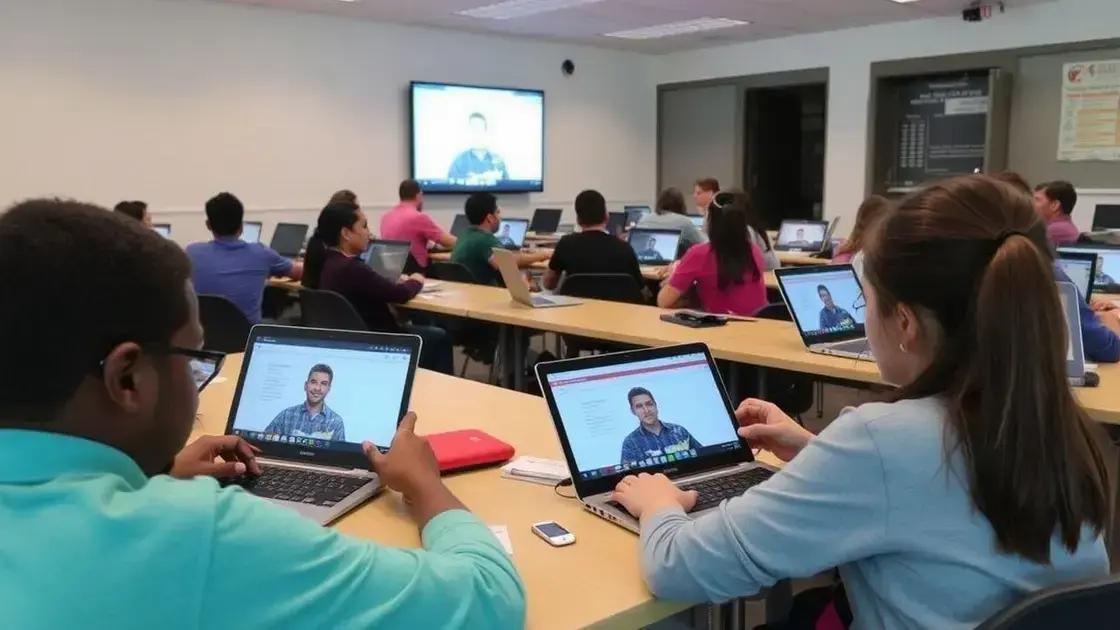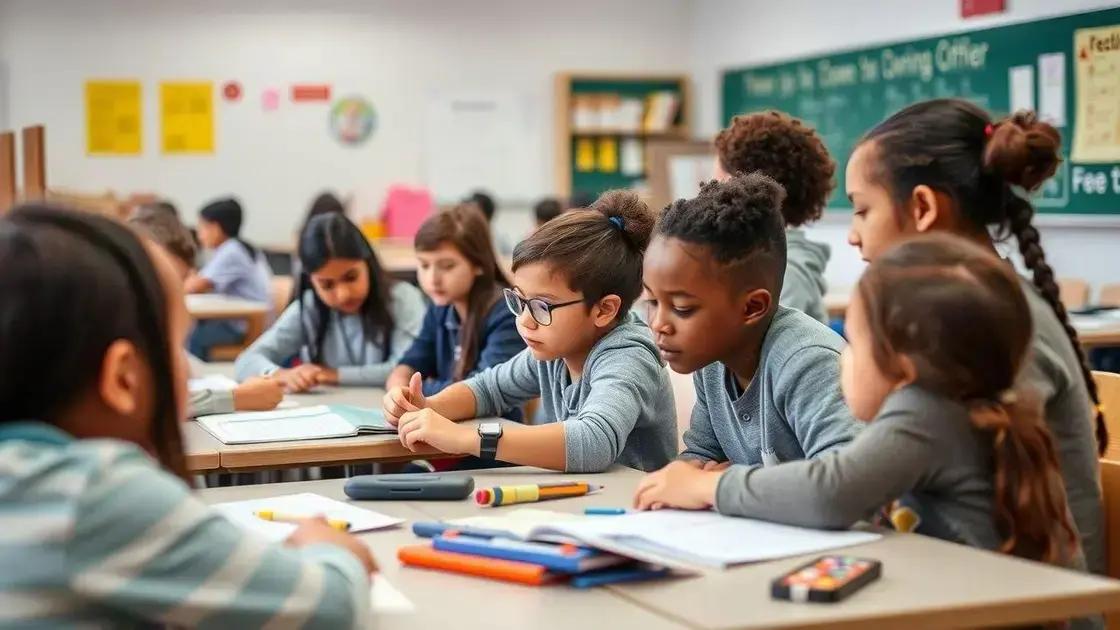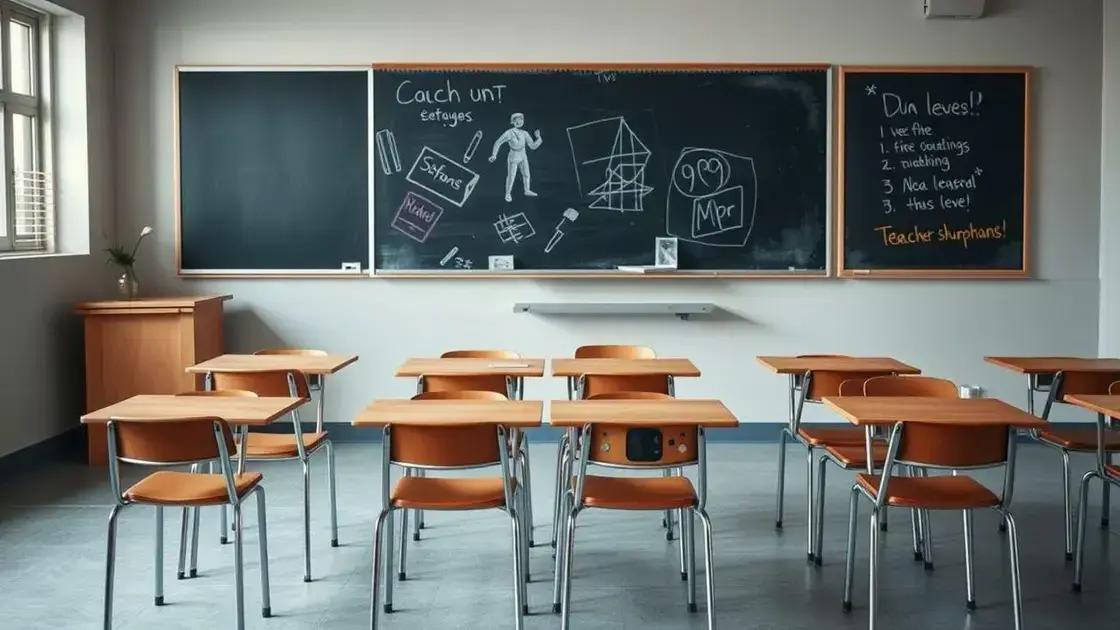Digital classrooms: transforming education for the future

Digital classrooms leverage technology to enhance education, offering personalized learning experiences, flexibility, and access to varied resources while addressing challenges like technology access and student engagement.
Digital classrooms are changing the face of education as we know it. Have you ever wondered how technology in education can enhance learning experiences for students? In this article, we’ll dive into the concept of digital classrooms and explore their impact on modern education.
What are digital classrooms?
Digital classrooms are innovative learning environments that blend traditional education with advanced technology. They offer students a unique way to engage with their studies, connecting them to resources and ideas beyond the classroom.
In essence, a digital classroom utilizes the internet and specific software to create a learning space that transcends physical boundaries. Students can participate in classes from anywhere, all they need is an internet connection. This flexibility allows for a more tailored learning experience.
Features of digital classrooms
Several key features make digital classrooms effective:
- Interactive Tools: Digital classrooms often employ tools like video conferencing, discussion boards, or interactive quizzes.
- Resource Accessibility: Students have easy access to digital textbooks, online libraries, and other educational resources.
- Real-time Feedback: Teachers can provide immediate feedback on assignments and discussions, fostering better communication.
- Collaborative Learning: Students can work together on projects using online platforms, enhancing teamwork skills.
As technology continues to evolve, digital classrooms incorporate new features to enhance learning. For instance, virtual reality (VR) can provide immersive experiences, making subjects more vivid and engaging. Imagine learning about ancient civilizations by virtually visiting a pyramid! This is just one example of how digital classrooms can bring lessons to life.
Furthermore, the adaptability of digital classrooms is a significant advantage. Educators can tailor lessons to different learning styles, ensuring that every student can thrive. Whether it’s through visual aids, interactive discussions, or hands-on projects offered online, the goal is to create a comprehensive learning experience that meets individual needs.
In summary, digital classrooms represent the future of education, marrying the benefits of technology with the principles of effective teaching. They encourage engagement, creativity, and collaboration among students, making learning a more dynamic and enjoyable process.
Benefits of digital classrooms for students
There are many benefits of digital classrooms for students, making learning more engaging and effective. Understanding these advantages can help educators and parents appreciate the shift to technology-enhanced learning environments.
One of the key benefits is accessibility. Students can access learning materials anytime and anywhere. This flexibility allows them to learn at their own pace, revisiting difficult topics or advancing quickly through lessons they find easier. This personalized approach can lead to better retention of knowledge.
Enhanced Engagement
Digital classrooms provide interactive learning experiences that capture students’ interest.
- Interactive Content: Features like quizzes, videos, and games keep students involved.
- Collaborative Tools: Tools like forums and group projects boost teamwork and problem-solving skills.
- Visual Learning: Multimedia resources cater to different learning styles and enhance understanding.
- Instant Feedback: Students receive immediate responses on their work, helping them improve quickly.
Another significant advantage is that digital classrooms prepare students for the future. In our technology-driven world, having skills in digital communication, online collaboration, and tech-based problem solving is crucial. Students learn to navigate digital tools, which will be valuable in their careers.
Moreover, digital classrooms can support diverse learners by providing various resources tailored to individual needs. For instance, students with different learning styles can choose from videos, articles, or interactive modules. Teachers can also easily adjust lesson plans to meet the unique requirements of their students, ensuring everyone has the opportunity to succeed.
Additionally, by using data analytics, educators in digital classrooms can track student progress more effectively. They can identify areas where a student might be struggling and provide extra support as needed. This data-driven approach results in more targeted instruction and better educational outcomes.
Key tools used in digital classrooms

Understanding the key tools used in digital classrooms can help clarify how they enhance the learning experience. These tools improve engagement and facilitate learning for students of all ages. By leveraging technology, educators can create dynamic and interactive learning environments.
One major category of tools is communication platforms. These platforms allow teachers and students to connect easily, share information, and collaborate. Some popular communication tools include:
- Video Conferencing Software: Applications like Zoom or Google Meet enable real-time interaction between students and teachers.
- Messaging Apps: Tools like Slack or Microsoft Teams help maintain ongoing conversations and discussions about assignments and projects.
- Discussion Forums: Online forums allow students to ask questions and engage with each other outside the classroom.
Another essential category is learning management systems (LMS). These systems provide a central hub for courses, materials, and communication. An effective LMS can offer:
- Course Management: Teachers can create and organize lessons, assignments, and resources in one place.
- Grade Tracking: Students and parents can easily monitor progress and grades.
- Resource Sharing: Teachers can share links, files, and activities that enhance learning.
In addition to communication and LMS, digital classrooms often utilize various educational tools. These may include:
- Interactive Whiteboards: These boards allow teachers to present lessons with visual aids, diagrams, and multimedia.
- Assessment Tools: Platforms like Kahoot! or Quizlet help teachers create engaging quizzes and assessment activities.
- Cloud Storage Solutions: Services like Google Drive or Dropbox provide easy access to materials and collaboration on group projects.
Ultimately, these key tools work together to create an enriched learning environment. They foster better communication, encourage collaboration, and support personalized learning for students.
Challenges faced by digital classrooms
While there are numerous benefits to digital classrooms, several challenges also arise in these new learning environments. Understanding these obstacles can help educators and schools develop strategies to overcome them.
One major challenge is the issue of technology access. Not all students have the necessary devices or reliable internet connections at home. This disparity can create inequality in learning opportunities. Schools must seek solutions to ensure all students have access to the required technology.
Managing Distractions
Another difficulty students face in digital classrooms is the potential for distractions. Being at home can lead to interruptions from family members, pets, or other distractions. Students might find it hard to focus on their studies. To combat this, teachers can offer tips on creating a dedicated study space free from interruptions.
Additionally, digital learning can lead to feelings of isolation. In traditional classrooms, social interactions among peers help build relationships. Without face-to-face contact, some students may feel disconnected from their classmates. Encouraging regular group activities and discussions can help maintain a sense of community.
Technical Issues
Technical problems are also common in digital classrooms. Software glitches, device malfunctions, or connectivity issues can disrupt lessons and frustrate both students and teachers. These hiccups can cause students to miss out on important information. Schools need to have tech support readily available to address these concerns and minimize disruptions.
Moreover, adapting teaching methods for digital formats can be challenging for educators. Not all teachers are trained in using technology effectively in their lessons. Continuous professional development in tech integration is essential to help teachers successfully navigate this shift.
In summary, while digital classrooms provide exciting opportunities for learning, they are not without challenges. By addressing technology access, minimizing distractions, fostering social connections, managing technical issues, and enhancing teacher training, schools can create a more effective learning environment.
Future trends in digital education
The future trends in digital education promise to reshape how students learn and interact in the classroom. As technology continues to advance, new opportunities for engaging and personalized learning experiences will emerge.
One significant trend is the increased use of artificial intelligence (AI) in education. AI can analyze student data to provide tailored learning pathways that meet individual needs. Imagine a system that adapts lessons based on a student’s learning pace, providing additional practice where needed. This personalization can improve student outcomes and engagement.
Virtual Reality in Learning
Another exciting development is the integration of virtual reality (VR) into education. VR can create immersive learning environments where students can explore subjects like history or science in a hands-on way. For instance, a student could take a virtual field trip to ancient Rome, enhancing their understanding of the material. Experiences like this make learning more engaging and can help students retain information better.
Gamification of Learning
Gamification is also becoming a significant part of digital education. By incorporating game elements into lessons, educators can motivate students to participate actively. Features like points, badges, and leaderboards encourage students to compete and engage with the material. As a result, learning becomes fun and rewarding.
Additionally, the use of blended learning models is on the rise. These models combine traditional face-to-face instruction with online learning components. Students can enjoy the benefits of in-person interaction while also having the flexibility to learn at their own pace through online resources. Blended learning can cater to different learning styles, making it easier for students to grasp challenging concepts.
Finally, as digital education evolves, we are likely to see a greater emphasis on soft skills development. Skills such as communication, collaboration, and critical thinking are essential for success in the modern workforce. Incorporating these skills into digital learning experiences will prepare students for real-world challenges.
In summary, the future of digital education is bright, with exciting trends like AI, VR, gamification, blended learning, and a focus on soft skills. As educators embrace these innovations, they’ll create richer, more engaging learning experiences for students.
In conclusion, digital classrooms have transformed education by making learning more engaging, personalized, and accessible. As we look to the future, trends such as artificial intelligence, virtual reality, and gamification will further enhance these learning environments. However, it’s essential to address challenges like technology access and distractions to ensure that all students benefit equally. By embracing these innovations while overcoming obstacles, educators can create richer experiences that prepare students for the demands of the 21st century.
FAQ – Frequently Asked Questions about Digital Classrooms
What are digital classrooms?
Digital classrooms are online learning environments that use technology to enhance education, allowing students to access lessons and resources remotely.
What tools are commonly used in digital classrooms?
Common tools include video conferencing software, learning management systems (LMS), and interactive educational applications that facilitate communication and learning.
What are the benefits of digital classrooms for students?
Benefits include personalized learning experiences, flexibility to learn at their own pace, and access to diverse educational resources.
What challenges do digital classrooms face?
Challenges include ensuring technology access for all students, managing distractions during remote learning, and addressing technical issues that can disrupt lessons.






